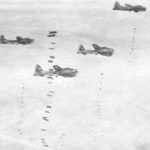The year 2016 marks the 100th anniversary of the “Escadrille Américaine” or the Lafayette Escadrille. Created on December 6, 1916, the Escadrille (or “squadron”) holds a unique place both in more »
Author: Chris Cottrill
 It’s December 17th — the anniversary of the Wright Brothers’ first machine powered air flight in Kitty Hawk, North Carolina. In remembrance of that date 109 years ago, the Smithsonian Libraries is featuring The Wright Flyer: An Engineering Perspective by Howard S. Wolko and John David Anderson. The online version of this 1987 Smithsonian Institution Press book is available via our Digital Library.
It’s December 17th — the anniversary of the Wright Brothers’ first machine powered air flight in Kitty Hawk, North Carolina. In remembrance of that date 109 years ago, the Smithsonian Libraries is featuring The Wright Flyer: An Engineering Perspective by Howard S. Wolko and John David Anderson. The online version of this 1987 Smithsonian Institution Press book is available via our Digital Library.
S O S – Ships in distress shall use the following signal repeated at brief intervals:…—… The 1906 International Wireless Telegraph Convention established the signal as the call for a more »



